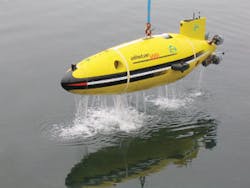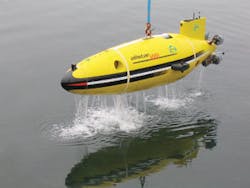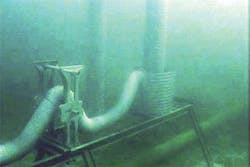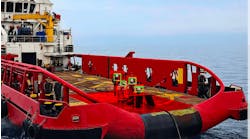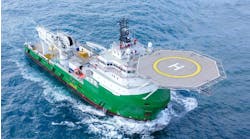Alistar AUV on track for inspection trials in the Gulf of Mexico
Daniel Scourzic, ECA
Each year, ROVs are employed to inspect thousands of kilometers of pipelines and numerous underwater structures such as X-mas trees. Carrying out these tasks usually involves contracting an expensive DP vessel fitted with a heavy set of equipment and many personnel operating the system.
Automated underwater vehicles (AUVs) conducting the same tasks will reduce these inconveniences. As an example, the inspection of an oil or gas field can be conducted by an AUV from an existing asset such as an FPSO, where neither winches nor umbilicals are required. But devolving these tasks to an AUV will also entail some specific features and developments.
The difficulty for pipeline inspection with an AUV lies mainly in the fact that the as-built reports, giving the position of these pipelines, are not accurate enough to allow pre-programming of a trajectory with waypoints above the pipeline to inspect it (approximately 5 to 10 m). Proper video inspection of a pipeline or a structure also means that the AUV must be very close to the pipe or structure, in order to obtain a serviceable video image.
This situation dictates the need for a vehicle with high manoeuvring capabilities, allowing the vehicle both to maintain its relative position to the pipe or structure, and also to avoid a collision with the seabed. This can only be achieved, in particular in areas with current, with a vehicle such as ECA’s Alistar 3000 system, developed in 2003, which is equipped with a specific set of sensors.
Pipeline inspection capabilities for the Alistar 3000 have been under development since early in 2004. The current configuration enables the vehicle to:
• automatically detect and ‘lock’ onto the pipe;
• follow the pipe, even when buried, 1 and 2 m above it;
• detect CP anodes and anomalies such as debris located next to the pipe;
• record video and sonar images of the pipe; and
• send video images of the pipe to the supervision team on the vessel.
During the mission, the vehicle’s absolute position is also recorded, enabling it to give the position of the pipe and compare this to its theoretical position. When the vehicle is recovered onboard the vessel, all data and images recorded are then uploaded for subsequent post-processing and presented to the customer using modern techniques such as mozaicing.
In addition to pipe inspection, ECA is also conducting underwater structure inspection development. The aim of this work is for the Alistar 3000 to be able to fly around an underwater structure in order to record video and sonar images of the structure. These will then be analyzed onboard the vessel once the Alistar vehicle is recovered and the data retrieved.
In early 2005, BP contracted ECA for a demonstration of pipeline and underwater structure inspection.
The offshore sea trial using the Alistar 3000 Inspection AUV was designed by BP to evaluate the technology. It will be located in the company’s deepwater King Field (1,700 msw) in the GoM and will comprise the following three levels of trial tasks:
• Level 1: Passive pipeline inspection: Alistar 3000 will detect and follow a pipeline at various altitudes above the pipeline while recording video, sonar data, and actual position of the flowline.
• Level 2: Active pipeline inspection: the vehicle, using onboard sensors that can automatically detect anodes or anomalies while tracking the flowline, will actively modify its mission to carry out closer general visual inspection (GVI) of the detected features.
• Level 3: Structure inspection: Alistar 3000 will follow the flowline to a pipeline end structure and will process in real-time sensor information in order to maneuver around the structure to perform a GVI.
A first phase of the demo was successfully carried out last December offshore Toulon, southeast France, which partially demonstrated the requirements of Level 1 and Level 2.
During this program, an acoustic sensor was used to track the pipe; a CP probe was applied to detect anodes; and a magnetomer for magnetic anomalies was laid down next to the inspected pipe. Following either an anode or magnetic anomaly detection, the Alistar 3000 autonomously performed a GVI of the relevant pipe section.
The vehicle was tracked from the surface vessel using an ultra-short baseline system and was controlled using a low rate acoustic link. This allowed relaying to the surface of the vehicle parameters and sending of orders to the vehicle.
A high rate acoustic link was also deployed to transmit video images of the pipe to the supervision team on the vessel.
The second phase of the demonstration will be conducted in the GoM some time this spring.•
